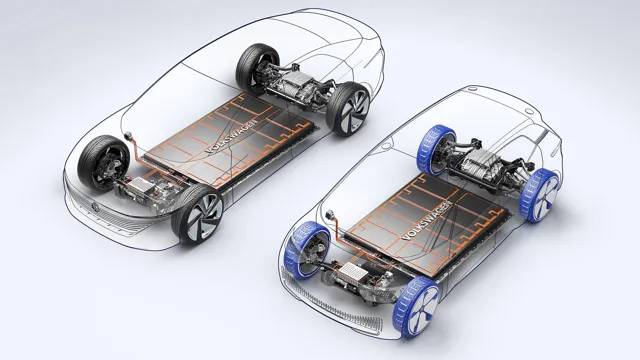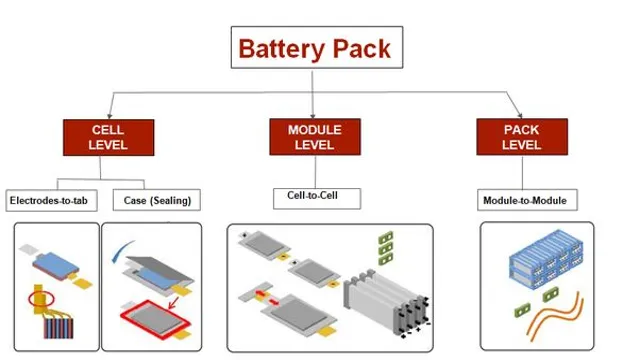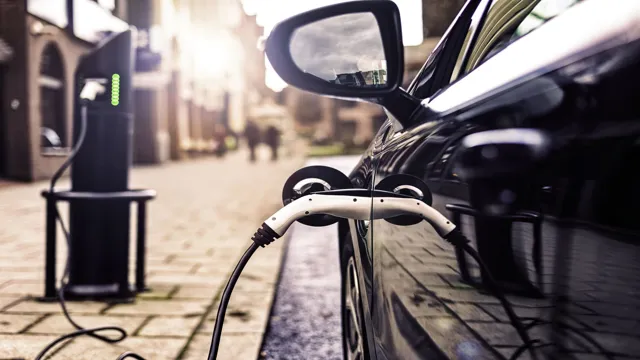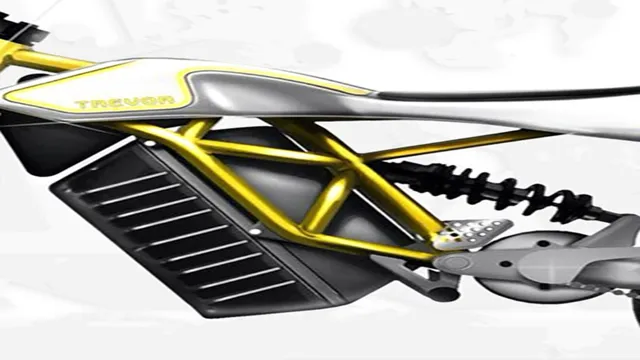The Secret Behind Electric Cars: Unveiling the Intricate Battery Pack Diagram
Electric cars are becoming more popular as people realize the benefits of owning one, from being more environmentally friendly to saving money on gas. But have you ever wondered how the battery pack in an electric car actually works? In this blog, we will take a closer look at the electric car battery pack diagram and explain how it operates. An electric car battery pack is composed of multiple lithium-ion battery cells, similar to the ones found in everyday electronics like laptops and cell phones.
These cells are arranged in modules or blocks, which are then connected together to form the battery pack. The battery cells generate electricity through a chemical reaction and can store enough energy to power an electric vehicle for hundreds of miles. The diagram of an electric car battery pack shows the various components that make up the system, including the battery cells, modules, cooling system, and control system.
The cooling system ensures that the battery doesn’t overheat, while the control system monitors the power usage and controls the charging and discharging of the battery. Understanding the electric car battery pack diagram can help owners or enthusiasts better comprehend how the car operates and how to maintain it. For instance, the battery pack’s lifespan is influenced by various factors such as temperature and charging habits, so it’s essential to take care of it properly.
In conclusion, the electric car battery pack diagram is a crucial piece in understanding how electric cars work. As the world shifts towards more sustainable and eco-friendly options, it’s vital to grasp the technology powering these changes. We hope this blog has provided you with a clearer understanding of how electric car battery packs work and inspires curiosity for further research.
What is an Electric Car Battery Pack?
An electric car battery pack is the heart and soul of an electric vehicle (EV). It is made up of numerous lithium-ion batteries that work together to power the car’s electric motor. The battery pack is usually placed on the floor of the car, and it is responsible for storing and delivering energy to the electric motor.
But what does an electric car battery pack diagram look like? Imagine a rectangular box that is comprised of smaller units, each of which is a lithium-ion cell. The cells are connected to one another by a series of wires and circuit boards, forming a complex network that allows for the efficient flow of energy from the batteries to the motor. The battery pack requires a specialized cooling system to maintain a constant temperature, which is essential for its longevity and safety.
Overall, an electric car battery pack diagram may seem complex, but its purpose is simple: to provide power to an electric car’s motor while being environmentally friendly.
Understanding the Basics
An electric car battery pack is essentially the heart of an electric vehicle. It’s responsible for storing all the energy needed to power the car’s electric motor. Similar to the battery in your phone, an electric car battery pack is rechargeable, and depending on the model, can provide anywhere from tens to hundreds of miles of driving range before needing to be recharged.
Most battery packs use lithium-ion technology, which is known for its high energy density, long cycle life, and fast charging capabilities. Think of it like a fuel tank in a conventional car, but instead of filling it up with gasoline, you plug it in to recharge. The electric car battery pack is the key to unlocking the benefits of electric cars, such as zero emissions, lower fuel costs, and reduced dependence on fossil fuels.

Battery Pack Components
An electric car battery pack is a set of rechargeable batteries that power the electric motor of your car. Its components include lithium-ion cells, battery management systems, battery cooling systems, and power electronics. These batteries convert chemical energy into electrical energy and are responsible for providing the necessary power to drive your car.
The battery management system ensures that the battery pack operates safely and optimally, while the cooling system prevents overheating and damage to the battery. Power electronics manage the flow of electricity to and from the battery, routing power to the motor or regenerating power during braking. When selecting an electric car, it is essential to consider the battery pack’s capacity, charging time, and range to ensure that it is suitable for your needs.
With the increasing popularity of electric cars, battery technology is continually evolving, with newer batteries offering longer ranges and faster charging times.
How Does an Electric Car Battery Pack Work?
When it comes to electric vehicles, the battery pack plays a crucial role in powering the car. The electric car battery pack diagram is composed of multiple cells, each holding an anode, a cathode, and an electrolyte. These cells are then connected together to form a larger battery pack that can deliver the required voltage to power the car.
The battery pack also includes a Battery Management System (BMS), which controls the charging and discharging of the battery. The BMS ensures that each cell is charging and discharging evenly, which is important to maintain the overall health of the battery pack. When driving, the battery provides power to the electric motor, which in turn powers the wheels.
Recharging the battery is done through regenerative braking or by plugging the car into an electrical outlet. Overall, the electric car battery pack contains the crucial components necessary to power the electric vehicle and make it a viable alternative to traditional gasoline-powered cars.
Charging and Discharging
An electric car battery pack is the powerhouse that drives your car. It works by storing energy that is used to power the electric motor, just like how petrol or diesel fuels a combustion engine. The battery pack is made up of many individual battery cells that are tightly packed together.
Each cell is made up of a positive electrode, a negative electrode, and an electrolyte. When you charge the battery, electricity flows through the positive electrode and into the negative electrode, creating a chemical reaction that stores energy in the battery. When you discharge the battery, the opposite happens – the stored energy is released and used to power the electric motor.
The amount of energy stored in the battery pack determines how far you can drive your electric car. Charging times and range can vary depending on the type of battery and charging infrastructure used, so it’s important to do your research before purchasing an electric car. Looking for a more sustainable way to travel? Consider an electric car – it’s environmentally friendly and easy on the wallet in the long run.
Power Management
An electric car battery pack is a crucial component that stores energy used to power the vehicle. It is made up of a collection of lithium-ion battery cells, wired together in a series or parallel to generate the voltage and current required to operate the car’s motor. The individual cells typically have a nominal voltage of
6-7 volts, and a capacity of around 3-4 ampere-hours. The number of cells used in a battery pack can range from hundreds to thousands, depending on the vehicle’s range and performance requirements.
To efficiently manage and monitor the battery pack, a sophisticated battery management system (BMS) is used. The BMS provides critical information such as the state of charge, temperature, and voltage of each battery cell, enabling the car’s computer to ensure the battery operates in a safe and optimal range. When the vehicle is not in use, the battery pack can be charged from an external power source, which typically takes a few hours to complete.
Several charging methods are available, including standard AC charging, DC fast charging, and Tesla’s proprietary Supercharging network. Overall, an electric car battery pack has revolutionized the car industry, providing a cleaner and more sustainable form of transportation. With advancements in battery technology, range anxiety is becoming less of an issue, and many drivers are now opting for electric vehicles as their primary mode of transportation.
Battery Maintenance and Longevity
Electric car batteries are a vital component of the vehicle’s powertrain, providing the energy necessary to propel the car forward. These batteries are made up of several individual cells, each containing two electrodes – a positive and negative – separated by an electrolyte. When the car is charging, electric current flows from the charger through the positive electrode to the negative electrode, creating a chemical reaction that stores energy in the battery.
When the car is in use, the process is reversed, with the battery releasing stored energy to power the car’s electric motor. To maximize the longevity and performance of electric car batteries, it’s important to prioritize proper maintenance, including regular charging and avoiding extreme temperatures. This will ensure that the battery pack remains healthy and efficient, providing reliable power for the lifespan of the vehicle.
Types of Electric Car Battery Packs
An electric car battery pack typically consists of several battery cells arranged in series or parallel to store energy. The two main types of electric car battery packs are nickel-metal hydride (NiMH) and lithium-ion (Li-ion) batteries. NiMH batteries are often found in older electric cars and have a lower energy density and shorter lifespan than Li-ion batteries.
In contrast, Li-ion batteries are lighter, more efficient, and have a higher energy density, which allows them to provide a longer driving range. The diagram of an electric car battery pack typically shows how these battery cells are arranged and connected to form the pack. Generally, the pack connects to the electric motor to power the vehicle, while also providing energy to other electrical systems such as headlights and air conditioning.
The battery pack is a critical component of an electric car, and understanding its types and construction can aid in making informed decisions about purchasing an electric car.
Lithium-Ion Battery Packs
Lithium-ion battery packs are the most common type of battery used in electric cars today. These battery packs come in several different types, including nickel-metal hydride (NiMH) and lithium polymer (LiPo) batteries. NiMH batteries are popular due to their low cost and high energy density, but they are heavier and less efficient than other types of batteries.
LiPo batteries, on the other hand, are lightweight and have a higher energy density, but they are more expensive and require special handling to avoid overheating. Despite their differences, all lithium-ion battery packs are designed to store and release energy efficiently, ensuring that electric cars can travel long distances on a single charge. So, whether you’re shopping for a new electric vehicle or just interested in the technology behind them, it’s important to understand the different types of battery packs available and how they can impact your driving experience.
Nickel-Metal Hydride Battery Packs
One of the most important components of an electric car is its battery pack, which powers the vehicle by delivering electricity to the motor. When choosing a battery pack, it is essential to consider the type of battery chemistry used. One of the most popular types of electric car battery packs is the Nickel-Metal Hydride (NiMH) battery pack.
These battery packs are similar to the Nickel-Cadmium (NiCd) battery packs but are much more environmentally friendly. They have a higher energy density and can store more energy than NiCd battery packs, making them more ideal for electric vehicles. NiMH battery packs are also less prone to “memory effect,” where the battery loses its capacity to hold a charge over time.
Because of this, NiMH batteries are an excellent choice for those who want a more reliable, long-lasting battery pack for their electric car. Overall, the NiMH battery pack is a solid choice for electric car owners who want a combination of reliability, energy density, and environmental friendliness.
Choosing the Right Electric Car Battery Pack
Electric car battery packs are essential for powering your car, and choosing the right one is a crucial decision to make. Understanding the electric car battery pack diagram can help you identify the right battery pack for your vehicle. The battery pack consists of individual battery cells, which are connected in series or parallel to achieve the desired voltage and capacity.
The series connection increases the total voltage of the battery, while the parallel connection increases the total capacity. The number of cells and the configuration of the battery pack depend on the type of electric car and its power requirements. It is essential to consider the range, battery life, and charging time of the battery pack when choosing the right one for your electric car.
By understanding the electric car battery pack diagram, you can make an informed decision and ensure that your vehicle gets the best power source.
Factors to Consider
When it comes to choosing the right electric car battery pack, several vital factors must be considered, such as range, performance, and cost. The range refers to how long the battery can last on a single charge and is considered a crucial factor for any electric car. Performance, on the other hand, is all about your driving habits, the terrain, and your speed.
The battery must be able to provide sufficient energy to power your car in different driving conditions. The cost of electric car batteries is also important. While electric cars are generally more expensive than their traditional counterparts, their long-term cost savings, including fuel, maintenance, and taxes, often make up for the initial expense.
Additionally, your daily driving distance and charging infrastructure must be taken into account. If you frequently drive long distances, you may want to opt for a battery with a higher range to avoid the hassle of frequent charging stops. Overall, it’s essential to choose a battery pack that matches your driving needs and budget to ensure a pleasant and cost-effective driving experience.
Popular Brands and Models
When it comes to choosing the right electric car battery pack, things can get overwhelming quickly. With so many popular brands and models out there, it can be tough to know where to start. But fear not, there are a few key factors to consider that can help steer you in the right direction.
Firstly, you’ll want to consider the size or capacity of the battery pack. The larger the capacity, the further you can travel without needing to recharge. Next, take into account the type of battery chemistry being used.
Lithium-ion batteries are the most common and offer a good combination of performance, weight, and cost. Lastly, you’ll want to consider factors such as warranty, charging time, and any additional features or technology offered by the battery pack. By taking these factors into account, you can find the right electric car battery pack that meets your needs and fits your budget.
So get out there and start exploring the world of electric car batteries today!
Conclusion
In conclusion, the electric car battery pack diagram is a shining example of innovative technology and sustainable transportation. By generating energy through renewable sources, electric cars offer a dynamic and eco-friendly alternative to traditional gasoline-powered vehicles. So, next time you’re cruising down the road in your electric car, think about the intricate system that powers your ride, and pat yourself on the back for making a wise and forward-thinking choice.
After all, the future is electric, and you’re leading the charge!”
FAQs
What is the function of the battery pack in an electric car?
The battery pack in an electric car stores the electricity needed to power the car’s motor.
What types of batteries are used in electric car battery packs?
Lithium-ion batteries are commonly used in electric car battery packs due to their high energy density.
How long does an electric car battery pack typically last?
The lifespan of an electric car battery pack varies depending on factors such as usage patterns and environmental conditions, but most battery packs are designed to last for at least 100,000 miles.
Can an electric car battery pack be replaced?
Yes, if an electric car battery pack becomes degraded or damaged, it can be replaced with a new or refurbished battery pack. However, this can be an expensive and time-consuming process.







